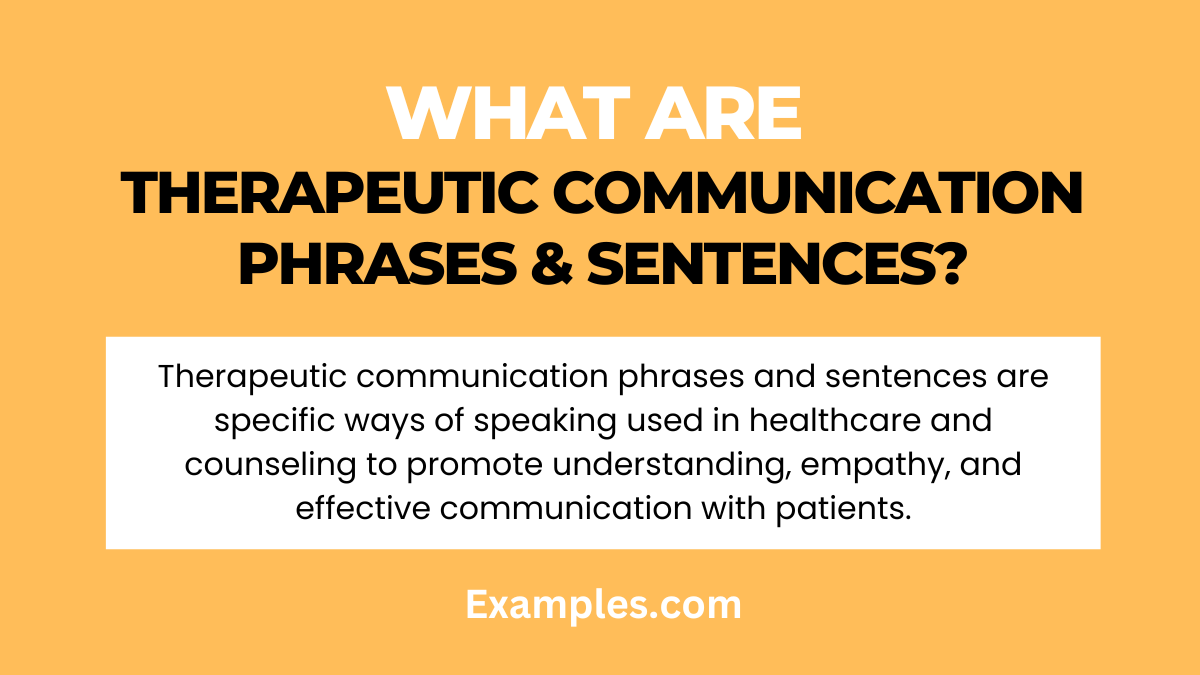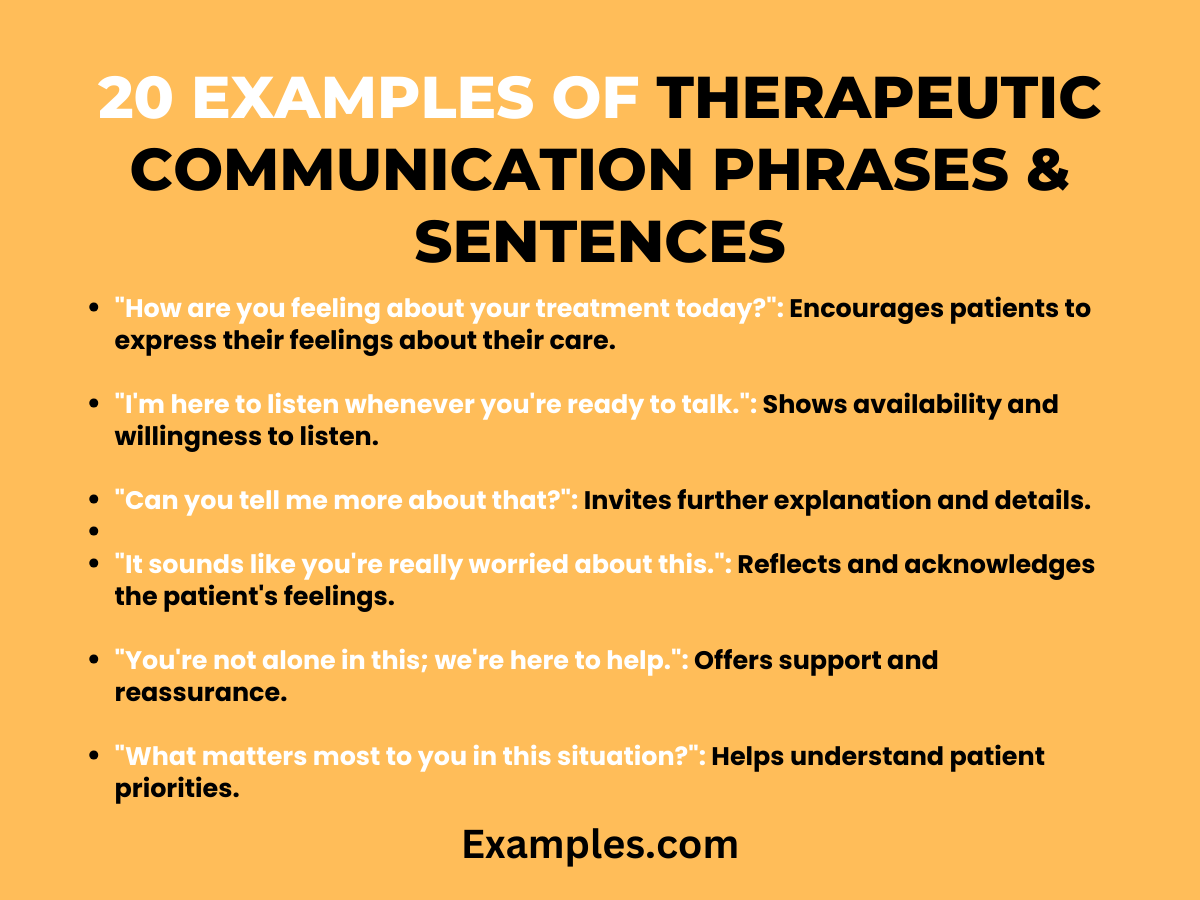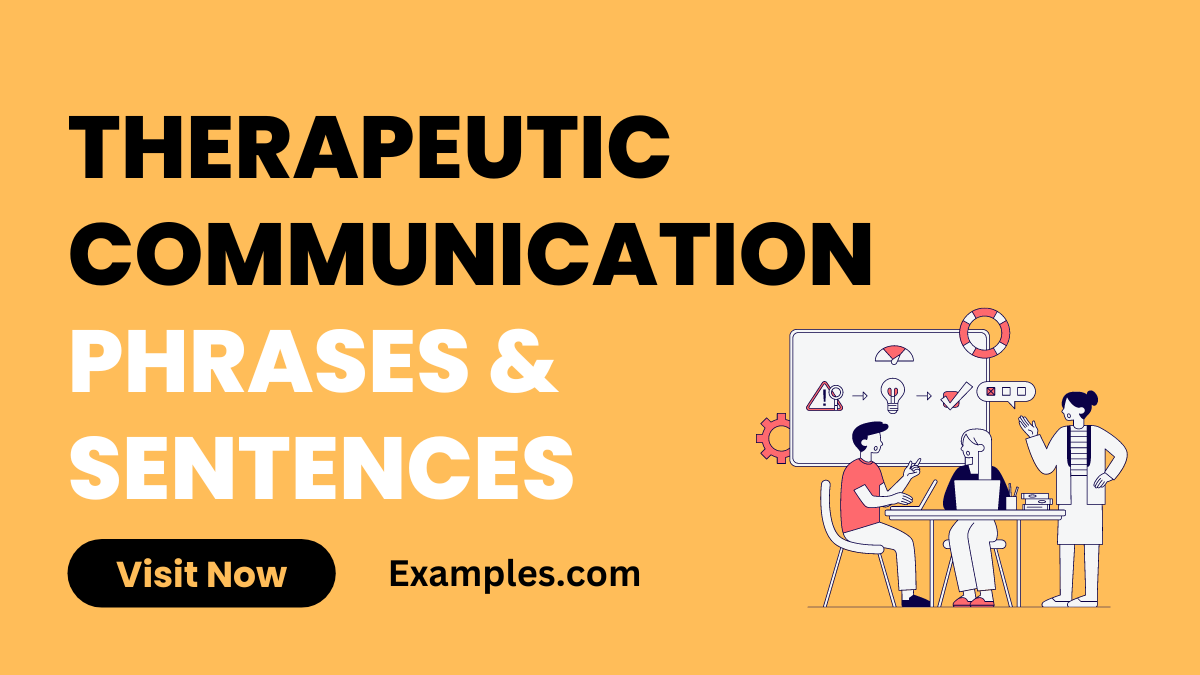19+ Therapeutic Communication Phrases & Sentences Examples
What are Therapeutic Communication Phrases & Sentences?

Therapeutic communication phrases and sentences are specific ways of speaking used in healthcare and counseling to promote understanding, empathy, and effective communication with patients. These phrases are designed to create a safe and supportive environment, encouraging patients to express their thoughts and feelings openly. They include techniques like active listening, showing empathy, and asking open-ended questions. These phrases help in building trust, reducing patient anxiety, and enhancing the overall quality of care by ensuring that patients feel heard and understood.
20 Examples of Therapeutic Communication Phrases & Sentences
Therapeutic communication is vital in healthcare, enhancing patient interaction and support. This guide presents 20 examples of phrases and sentences that embody therapeutic communication. Each example is designed to foster understanding, empathy, and connection between healthcare professionals and patients. These phrases and sentences are powerful tools in various clinical scenarios, aiding in building trust, clarifying concerns, and providing comfort.

- “How are you feeling about your treatment today?”: Encourages patients to express their feelings about their care.
Example: This question opens up a conversation about the patient’s perspective on their treatment, showing that their opinion is valued. - “I’m here to listen whenever you’re ready to talk.”: Shows availability and willingness to listen.
Example: This phrase offers support and patience, letting the patient know they can share at their own pace. - “Can you tell me more about that?”: Invites further explanation and details.
Example: This question encourages deeper conversation, showing genuine interest in the patient’s experience. - “It sounds like you’re really worried about this.”: Reflects and acknowledges the patient’s feelings.
Example: This empathetic statement validates the patient’s concerns and feelings, fostering a sense of understanding. - “You’re not alone in this; we’re here to help.”: Offers support and reassurance.
Example: This phrase helps reduce feelings of isolation by emphasizing teamwork and support. - “What matters most to you in this situation?”: Helps understand patient priorities.
Example: Asking this question shows respect for the patient’s values and helps tailor care to their needs. - “Let’s go over your options together.”: Promotes shared decision-making.
Example: This sentence encourages collaboration and ensures the patient feels involved in their care planning. - “That’s a very good question; let me explain.”: Responds positively to patient queries.
Example: Acknowledging the patient’s curiosity and providing clear answers builds trust and clarity. - “I can see why you’d feel that way.”: Validates patient emotions.
Example: Expressing understanding of the patient’s feelings strengthens the therapeutic bond. - “Tell me how you’ve been coping with your illness.”: Encourages sharing coping strategies.
Example: This question allows patients to discuss their resilience and challenges, offering insight into their emotional state.
Phrases of Therapeutic Communication
Phrases of therapeutic communication are key elements that facilitate effective and empathetic interactions in healthcare. These phrases are specifically designed to build trust, demonstrate understanding, and encourage patients to share their thoughts and feelings. This guide delves into the most impactful phrases used in therapeutic communication, highlighting their significance and application in clinical settings.

Demonstrating Empathy and Understanding
Phrases like “I can see how that might be difficult for you,” or “It sounds like you’re really struggling with this,” are crucial in conveying empathy. They show patients that their feelings are acknowledged and understood, which is essential in building a therapeutic relationship.
Encouraging Expression
Encouraging patients to express themselves is fundamental in therapeutic communication. Phrases such as “Can you tell me more about that?” or “How does that make you feel?” prompt patients to open up and share more about their experiences and emotions.
Validating Patient Feelings
Validation is a critical aspect of therapeutic communication. Phrases like “Your feelings are completely valid,” or “It’s understandable to feel that way given your situation,” help patients feel supported and reassured that their emotional responses are normal and acceptable.
Offering Support
Offering support through phrases like “I’m here to help you through this,” or “We can work on this together,” reinforces the idea that the patient is not alone in their journey. It emphasizes the collaborative nature of the healthcare relationship.
Providing Reassurance
Reassuring patients can alleviate anxiety and fear. Phrases such as “You’re in safe hands,” or “We’re doing everything we can to help you,” are powerful in providing comfort and reducing patient stress.
Reflecting and Clarifying
Reflective and clarifying phrases like “What I’m hearing is…,” or “Let me make sure I understand,” are useful in ensuring that the patient’s messages are being accurately received and understood. This helps prevent misunderstandings and ensures clear communication.
Sentences of Therapeutic Communication
Sentences of therapeutic communication are longer, more structured forms of communication that aim to deepen understanding, provide information, and guide patients through their healthcare journey. This part of the guide focuses on key sentences used in therapeutic communication and their role in enhancing patient care.
Building Rapport
Sentences such as “I remember you mentioned your love for gardening last time, how is that going?” are excellent for building rapport. They show personal interest and help in establishing a connection beyond the clinical aspects.
Exploring Patient Perspectives

Exploring patient perspectives is vital. Sentences like “I would like to understand more about your experience with this treatment,” invite patients to share their personal views and experiences, providing valuable insights for tailored care.
Educating and Informing
Providing information is a key component. Sentences such as “Let me explain what this medication does and how it might help you,” play a crucial role in educating patients about their treatment and care.
Setting Goals and Plans
Goal setting is important in therapeutic communication. Sentences like “Let’s discuss your goals for recovery and how we can achieve them together,” help in creating a clear and shared plan for the patient’s care and recovery.
Addressing Concerns and Questions
Addressing patient concerns directly is fundamental. Sentences like “I understand you have concerns about the side effects, let’s go through them together,” help in alleviating worries and ensuring the patient feels heard and cared for.
What are the Opening Statements for Therapeutic Communication?
Opening statements in therapeutic communication set the tone for a constructive and empathetic dialogue between healthcare providers and patients. These statements are crucial as they lay the foundation for trust, openness, and understanding in the therapeutic relationship. This guide will explore various opening statements that are effective in initiating therapeutic communication, emphasizing their significance in healthcare interactions.
Establishing a Welcoming Environment
The initial interaction in a therapeutic setting should convey a sense of warmth and acceptance. Opening statements like “I’m glad you’re here today. How can I assist you?” or “Welcome, I’m here to support you in any way I can,” are effective in creating a welcoming and safe environment. These statements reassure patients that they are in a caring and supportive setting.
Showing Empathy and Understanding
Empathetic opening statements are key in therapeutic communication. Phrases like “I understand this might be a difficult time for you, let’s talk about it,” demonstrate empathy and readiness to understand the patient’s perspective. This approach helps in breaking down barriers and encourages patients to share more openly.
Encouraging Open Communication
To promote open communication, it’s important to use opening statements that invite dialogue without pressure. Phrases such as “Feel free to share what’s on your mind, I’m here to listen,” encourage patients to express themselves freely. This kind of open invitation helps patients feel valued and understood.
Building Trust and Rapport
Trust and rapport are fundamental in therapeutic communication. Opening statements like “I want you to know that our conversations are confidential and this is a safe space for you,” help in establishing trust. Assuring patients of privacy and a non-judgmental environment is crucial in therapeutic settings.
Addressing Patient Concerns
Acknowledging and addressing patient concerns right from the beginning can be very effective. Using statements such as “I’d like to hear about any concerns you might have,” places importance on the patient’s worries and sets the stage for a patient-centered interaction.
Personalizing the Interaction
Personalized opening statements show that the healthcare provider sees the patient as an individual. Phrases like “I remember from our last session you mentioned… How has that been going?” indicate that the provider remembers and cares about the patient’s unique situation.
Clarifying the Purpose of the Interaction
It’s also beneficial to clarify the purpose of the interaction. Statements like “Today, I’d like to focus on… How does that sound to you?” help in setting clear objectives for the conversation, ensuring that both the patient and the healthcare provider are aligned in their goals.
In conclusion, the opening statements in therapeutic communication are pivotal in shaping the course of the interaction. They should be chosen carefully to establish a connection, build trust, and encourage openness. These statements are not just about beginning a conversation; they are about opening a pathway to healing and understanding in the therapeutic relationship.



